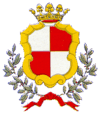Vasto
| Vasto | ||
|---|---|---|
| Comune | ||
| Città del Vasto | ||
|
Lighthouse of Punta Penna, the second tallest in Italy and seventh tallest in the world. | ||
| ||
 Vasto Location of Vasto in Italy | ||
| Coordinates: 42°06′42″N 14°42′30″E / 42.1118°N 14.7082°ECoordinates: 42°06′42″N 14°42′30″E / 42.1118°N 14.7082°E | ||
| Country | Italy | |
| Region | Abruzzo | |
| Province / Metropolitan city | Chieti (CH) | |
| Government | ||
| • Mayor | Francesco Menna (Partito Democratico) | |
| Area | ||
| • Total | 70.65 km2 (27.28 sq mi) | |
| Elevation | 138 m (453 ft) | |
| Population (1 January 2016)[1] | ||
| • Total | 41,087 | |
| • Density | 580/km2 (1,500/sq mi) | |
| Demonym(s) | Vastesi | |
| Time zone | CET (UTC+1) | |
| • Summer (DST) | CEST (UTC+2) | |
| Postal code | 66054 | |
| Dialing code | 0873 | |
| Patron saint | Saint Michael | |
| Saint day | September 29 | |
| Website | Official website | |
The Città del Vasto or Vasto (from the Greek Ἱστόνιον, Latin Histonium) is a town and comune on the Adriatic coast of the Province of Chieti in southern Abruzzo, Italy. It was also called in the Middle Ages as Guastaymonis or Il Vasto d'Ammone and also Waste d'Aimone.[2] Renamed Istonio under the Fascist Rule, it took the current name of Vasto in 1944. In the local dialect it is called Lu Uas'te, that is Il Vasto.
History
Classical
According to tradition, the town was founded by Diomedes, the Greek hero. The earliest archaeological relics date to 1300 BC. Histonium was one of the key towns of the Frentani, located on the Adriatic coast, about 9 kilometres (6 mi) south of the promontory called Punta Penna.
The city was noted by all the geographers among the towns of the Frentani and apparently under Julius Caesar[3] did not obtain the rank of a colonia, but continued to bear the title of a municipium, as we learn from some inscriptions.[4] Under the Roman Empire, the municipium of Histonium was a flourishing and opulent municipal town, and this is further attested by the existing remains, which include the vestiges of a theatre, baths, and other public edifices, besides numerous mosaics, statues, and columns of granite or marble.[5]
Among the numerous inscriptions which have been found, one of the most curious records the fact of a young boy named Lucius Valerius Pudens having at thirteen years of age won the prize for Latin poetry in the contest held at Rome in the temple of Jupiter Capitolinus.[6] The name of Histonium is still found in the Itineraries of the fourth century[7] and it probably never ceased to exist on its present site, though ravaged successively by the Goths, the Lombards, the Franks, and the Arabs.
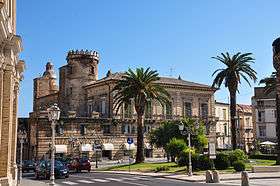
Histonium had no natural port, and it is not improbable that in the days of its prosperity it had a dependent port at the Punta Penna, where the current harbour that is the Porto di Vasto and the lighthouse are located, where there is good anchorage, and where Roman remains have also been found, which have been regarded, but probably erroneously, as those of the settlement of Buca.[8]
Medieval
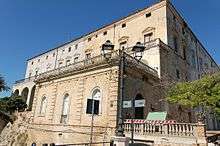
After the collapse of the Western Roman Empire, the Western half of the Empire became fully controlled by Germanic tribes until Justinian's Byzantine re-conquest, which included the province of Samnium, of which Histonium was a key town. However soon after Justinian's death, Histonium fell to the Lombards becoming incorporated into the Duchy of Benevento and, later, succumbing to the Franks c774AD. Normans under Robert Guiscard in turn captured the Duchy of Benevento in 1053. Around 1076, Histonium was renamed Guastaymonis, or the Waste of Aimone (Italian: Il Guasto d'Aimone), following raids, hence its current name. From the 13th century it was part of the Kingdom of Naples, which later merged into the Kingdom of the Two Sicilies.
In the 15th century the city's urban structure was transformed by the condottiero Giacomo Caldora, who had become its lord. The Caldora family built new city walls still seen today, including the Torre Bassano tower in Piazza Rossetti, the Torre Diomede in Vico Storto del Passero, the Torre Diamante in Piazza Verdi and Porta Catena, and with Castello Caldoresco as its primary defensive outpost.
In 1566 the Turkish Ottoman naval forces, led by Piyale Pasha, destroyed much of the city by fire, including the Castello Caldoresco, the Church of Santa Margherita and the Palazzo d'Avalos (formerly a home of Vittoria Colonna - close confidante of Michelangelo - now the Musei di Palazzo d'Avalos).
From Spanish rule until Italy's Unification
Under the Spanish rule of southern Italy, Vasto became fief of the Marquises d'Avalos, and under the reign of Cesare Michelangelo (marquis from 1697 to 1729), Vasto reached its zenith. Only superficially shaken by revolutionary events in 1799 (a short-lived Republic of Vasto was immediately overthrown by the sanfedista, or loyalists), the city's history was reflected in the nation's throughout the Restoration to the Unity of Italy when a liberal elite governed.
The poet and scholar Gabriele Rossetti was born in Vasto on 28 February 1783. Rossetti's published works include literary criticism, Romantic poetry such as his long poem Il Veggente in Solitudine of 1846, and his autobiography. Gabriele went into political exile in 1821, settling in London, England.
He was the father of well-known pre-Raphaelite painter Dante Gabriel Rossetti and poet Christina Rossetti. Gabriele died on 24 April 1854 and is buried in London's Highgate Cemetery with his wife Frances Polidori.
Modern
In the early 20th century, Vasto changed its architectural and urban features. The historical centre was redrawn and the foundations were set for drastic alterations during the 1920s and 1930s, with Mussolini decreeing a name change to Istonio in 1938, the official name until the liberation of the city from the Allied Forces in 1944.
Despite a devastating landslide (1956) that dragged a significant part of the eastern ridge - now Via Adriatica - into the gorge below, the years following World War II witnessed industrial, urban, and socio-cultural development. The city also discovered its tourist vocation: besides the progressive development of its beaches in Marina di Vasto, Roman-era thermal baths, mosaics, cisterns and remains of an amphitheatre were found and restored.
During the 1970s until the recent days, the town underwent a remarkable change and a fast growth, with several housing, road and other infrastructure projects built to accommodate the emigrating population from the inner areas of Southern Abruzzo, which have made it one of the most populous of the region.
Main sights
The old part of the town (centro storico) features a number of buildings and churches dating from the 12th-18th centuries, including:
- Vasto Cathedral (Cattedrale di San Giuseppe)
- Church of Santa Maria Maggiore, the largest and oldest (mentioned in a document as early as 1195) church in the town, with a quite tall bell tower. Damaged by the Turks in 1566,[9] and by a fire in 1645, it received a thorough restructuring in 1735 in which it got the current shape. It hosts one of alleged Jesus' crown of thorns (Sacra Spina).
- Castello Caldoresco
- D'Avalos Palace (Palazzo D'Avalos) and the Musei Civici
Below the hill on which the town is located, the beach resort town of Marina di Vasto offers a large sandy beach and several hotels and other facilities.
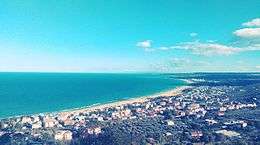
Further north the coast becomes rocky and features interesting pebble and stone beaches and coves, as well as the typical trabocchi, typical wooden fishing machines of the Southern Abruzzo coast. Amongst the natural areas, also featuring a number of sandy and rocky beaches, is the protected natural area of the Riserva Naturale di Punta Aderci, whose beaches were voted in 2014 third of the top 20 beaches in Italy.[10]
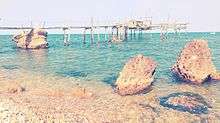
See also
- Vastese A Romance language from this town
References
- ↑ ISTAT 2011 Census data http://www.istat.it/it/files/2013/02/Dati-comunali-e-provinciali.zip?title=Superfici+delle+unit%C3%A0+amministrative+-+19%2Ffeb%2F2013+-+Dati+comunali+e+provinciali.zip
- ↑ Abruzzo - Bradt Guide, 2nd Edition, 2013, page 268
- ↑ (Mela ii. 4. § 9; Pliny the Elder iii. 12. s. 17; Ptolemy iii. 1. § 18; Lib. Colon. p. 260; August Wilhelm Zumpt, De Coloniis p. 307.
- ↑ Orell. Inscr. 2603, 4052; Zumpt, l. c..
- ↑ Romanelli, vol. iii. p. 32.
- ↑ Romanelli, l. c. p. 34; Orell. Inscr. 2603; Mommsen, I. R. N. 5252.)
- ↑ Antonine Itinerary p. 314; Tabula Peutingeriana.
- ↑ Mommsen, lnscr. Regn. Neap. p. 274, App. p. 30; who has collected and published all the genuine inscriptions found at Histonium.
- ↑ Chiese di Vasto: Santa Maria Maggiore, 2014, at the URL: http://www.vastospa.it/html/la_citt%E0/ch_s_maria.htm
- ↑ Legambiente, 2014 http://www.legambiente.it/contenuti/comunicati/le-spiagge-piu-belle-dell-estate-2014-cala-degli-infreschi-camerota-e-la-piu-ap
 This article incorporates text from a publication now in the public domain: Smith, William, ed. (1854–1857). "article name needed". Dictionary of Greek and Roman Geography. London: John Murray.
This article incorporates text from a publication now in the public domain: Smith, William, ed. (1854–1857). "article name needed". Dictionary of Greek and Roman Geography. London: John Murray.
External links
| Wikimedia Commons has media related to Vasto. |
| Wikisource has the text of the 1911 Encyclopædia Britannica article Vasto. |

